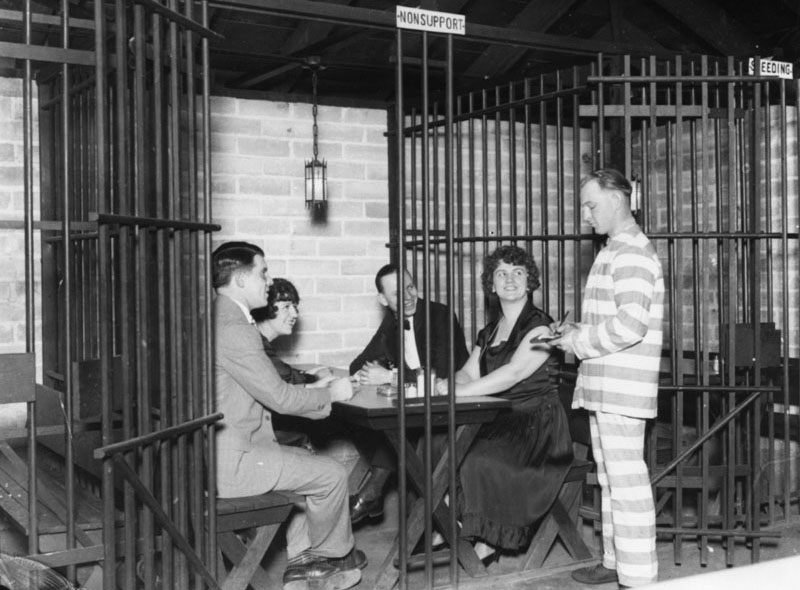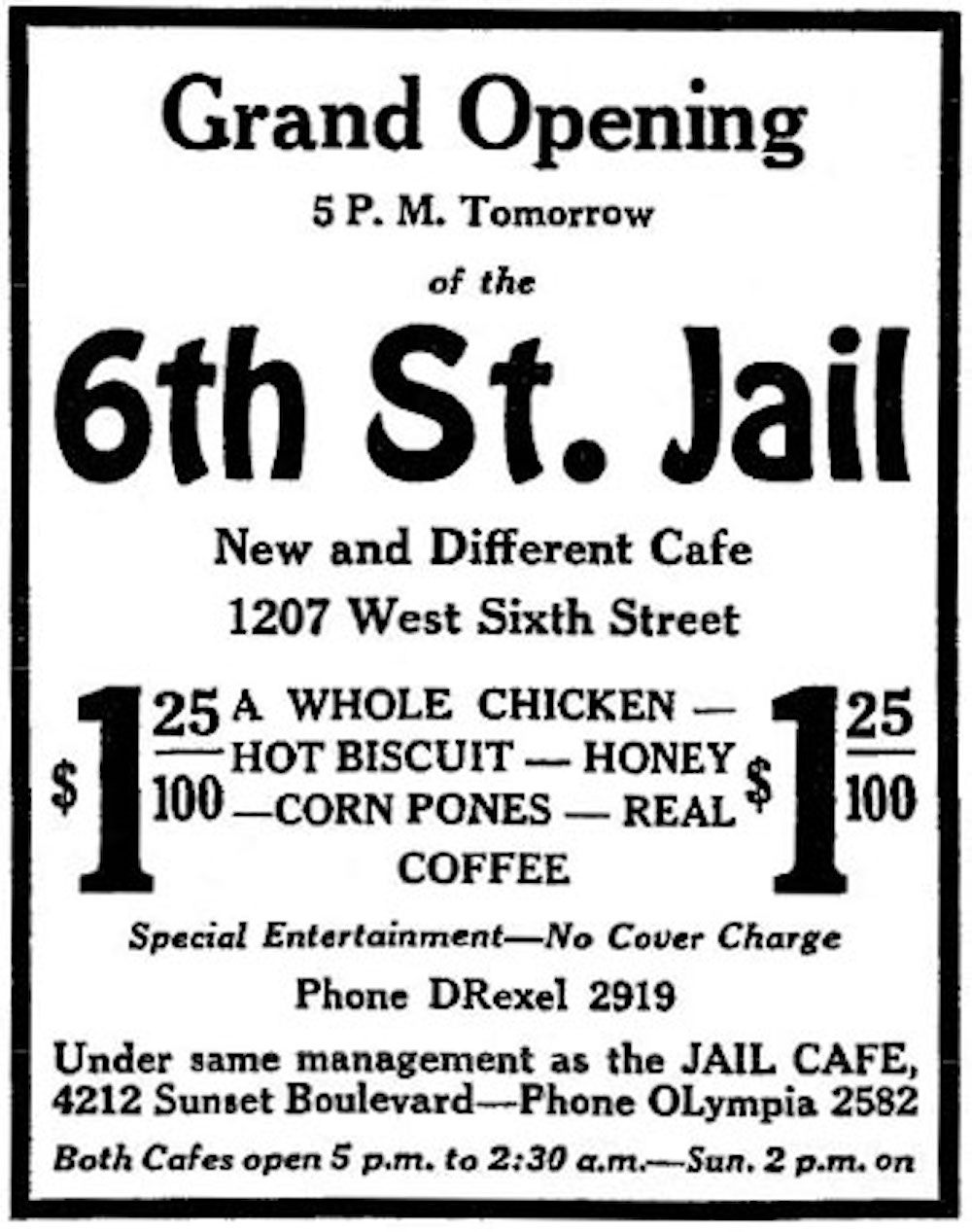Old Hollywood’s Best Theme Restaurants Specialized in Abductions and Dungeons
In 1920s L.A., a fun dinner meant getting locked up.

Customers who entered the Pirate’s Den, a 1940s Los Angeles theme restaurant and nightclub, risked becoming mock hostages during dinner. Waiters wearing pirate costumes regularly orchestrated fights that ended with female customers being taken to the restaurant’s “brig” until they screamed, at which point they were released with a “scream diploma.”
Owned by high-profile celebrities like Bing Crosby, Rudy Vallee, Bob Hope, Fred MacMurray, Johnny Weissmuller, and Errol Flynn, the Pirate’s Den became a popular destination for its celebrity sightings. But despite its upscale clientele, the restaurant’s pirate theme held strong: in addition to “kidnapping” its clientele, it featured a swearing parrot named Matey and managers who carried bullwhips in order to discipline the waiting staff (“the crew”). Interestingly, it was a controversy about the price of food (a man claimed that the Pirate’s Den overcharged him and his friends for beers and sandwiches), rather than the mock abductions of its customers, that eventually lost it favor with the Los Angeles public.

That Los Angeles served as the site of such a strange nightclub should be no surprise. The city, which now teems with stores built in the shape of giant donuts, submarines, hotdogs, and more, was the birthplace of the modern theme restaurant. In the early 20th century, according to historian Charles Perry, set designers looking for paying gigs often found work turning ordinary restaurants into theatrical establishments. The cinematic nature of venues like the Pirate’s Den also fit with the Hollywood mold—as movies took off, tourists came to the growing city expecting wild entertainment. Elaborately designed restaurants sprang up in order to capitalize on the frenzy.
Theme restaurants also became popular in L.A. in order to combat the overwhelming homogeneity of menus at the time. According to the Los Angeles Times: “When every place in town was serving steak, fried chicken and grilled cheese sandwiches, a colorful theme could help a restaurant stand out.”
Early theme restaurants included Baron Long’s Ship Café, a.k.a. Cabrillo’s, which opened in 1905 and was located on a boat; the Ye Bull Pen Inn, where customers ate in wood stalls; the Green Mill, whose building was designed to look like a windmill; and the Pink Rat Café, which “offered gothic castle decor, waiters dressed like pirates and shimmy dancing.”

One of the most elaborate was the Jail Café on Sunset Boulevard, which was designed to imitate a prison. Customers ducked down a long hallway until they reached the main dining area—a large room containing rows of mock prison cells. Waiters dressed as convicts sat them at tables located in these cells, locked the door, and served them a choice of chicken, steak, or lobster. In keeping with the jail theme, customers were forbidden from using utensils; they ate with their hands, reminiscent of the 1880s “beefsteak craze,” in which predominantly male customers sat on boxes in rustic restaurants, drank beer, and ate steak with their bare hands.
By the Jail Café entrance, posters of people dressed as inmates peeked out at the street through barred windows. Above them, a “warden” watched from his guard tower.
Bizarrely, a sign advertised in large font that the restaurant encouraged dancing, and a separate poster for the Jail Café’s two restaurant locations—the one on Sunset Boulevard and another that was later opened on 6th Street—promised that customers would “Laugh, eat, sing, play golf, music.” (A sticker at the bottom boasted its “large banquet cells.”) Apparently, even a place called the Jail Café had to spruce up the image of prison life.
Unlike the Pirate’s Den, the Jail Café did not stage crimes against its customers. But those who dined there in 1926, when an actual robbery occurred, probably would have liked to have known this in advance. According to a Variety article at the time: “When two bandits walked in and ordered everybody to throw their hands up, folks though it was part of the evening’s entertainment. However, they changed their minds when one of the bandits started going through their clothes and taking anything that looked valuable.”

Of Los Angeles’ numerous restaurant themes, prison was one of the most popular—and one of the most misrepresented. The Jail Café was part of a larger trend in which mostly white customers glorified a system that, in the U.S., disproportionately targeted and incarcerated black men.
The voyeurism likely began with the Café du Bagne in Paris, which opened in 1885 and had its waiters walk around with balls and chains attached to their ankles. At the turn of the century, similar restaurants popped up throughout the United States; a few years prior to the Jail Café, a prison-themed coffee shop, in which patrons scratched their names on the walls, celebrated its grand opening.
In 1930, the Jail Café earned a place on the newspaper Talking Screen’s “Seven Wonders of Hollywood” list. Mentioned alongside it was a new crop of Los Angeles theme restaurants, including the 24-hour Zep Diner—which was shaped like a Zeppelin and which sold “Hinden Burgers”—and the Pup Café, a stand in the shape of a big-eyed bulldog that looks so sad, one almost wonders whether it is grieving the food sold inside: hot dogs.





















Follow us on Twitter to get the latest on the world's hidden wonders.
Like us on Facebook to get the latest on the world's hidden wonders.
Follow us on Twitter Like us on Facebook